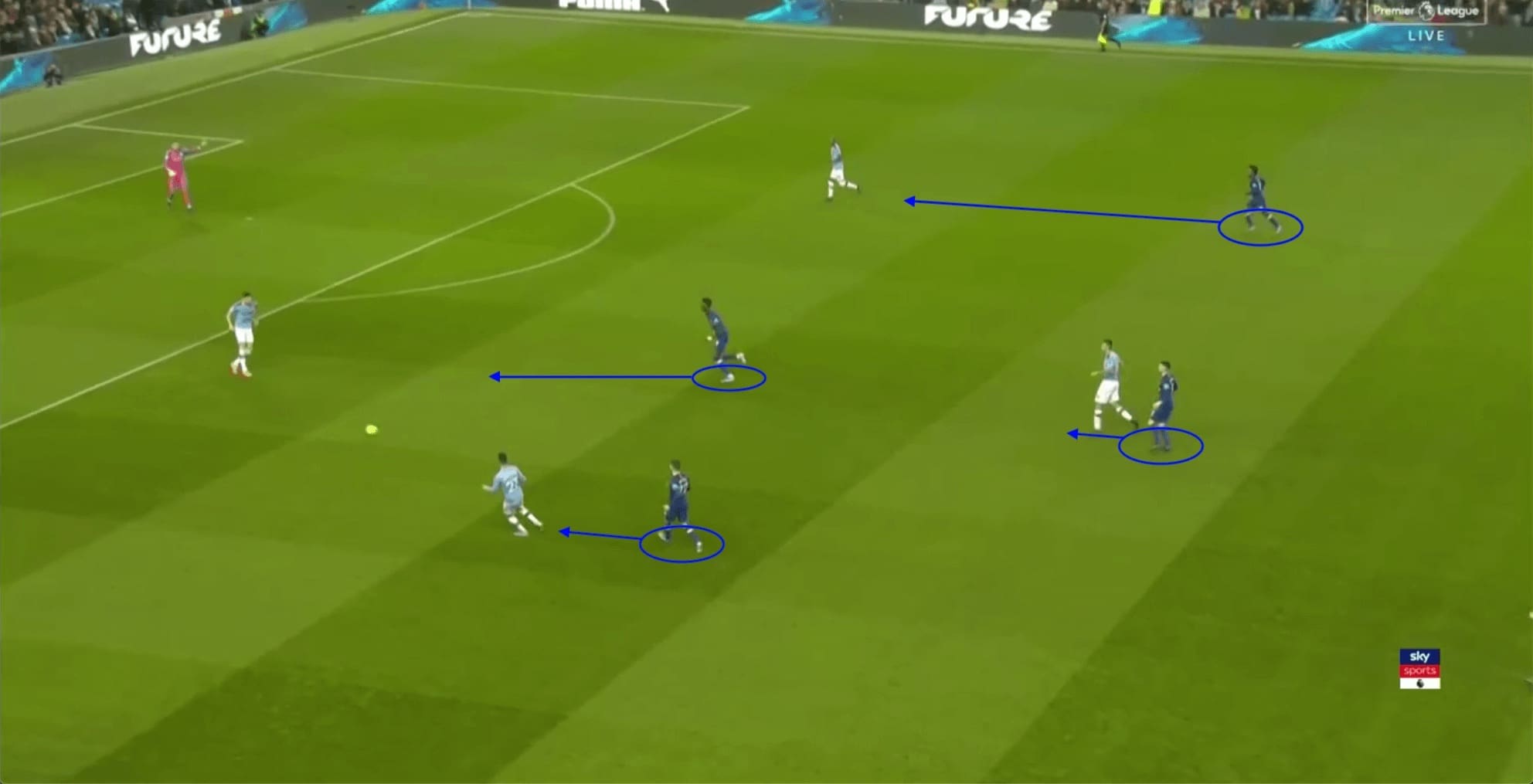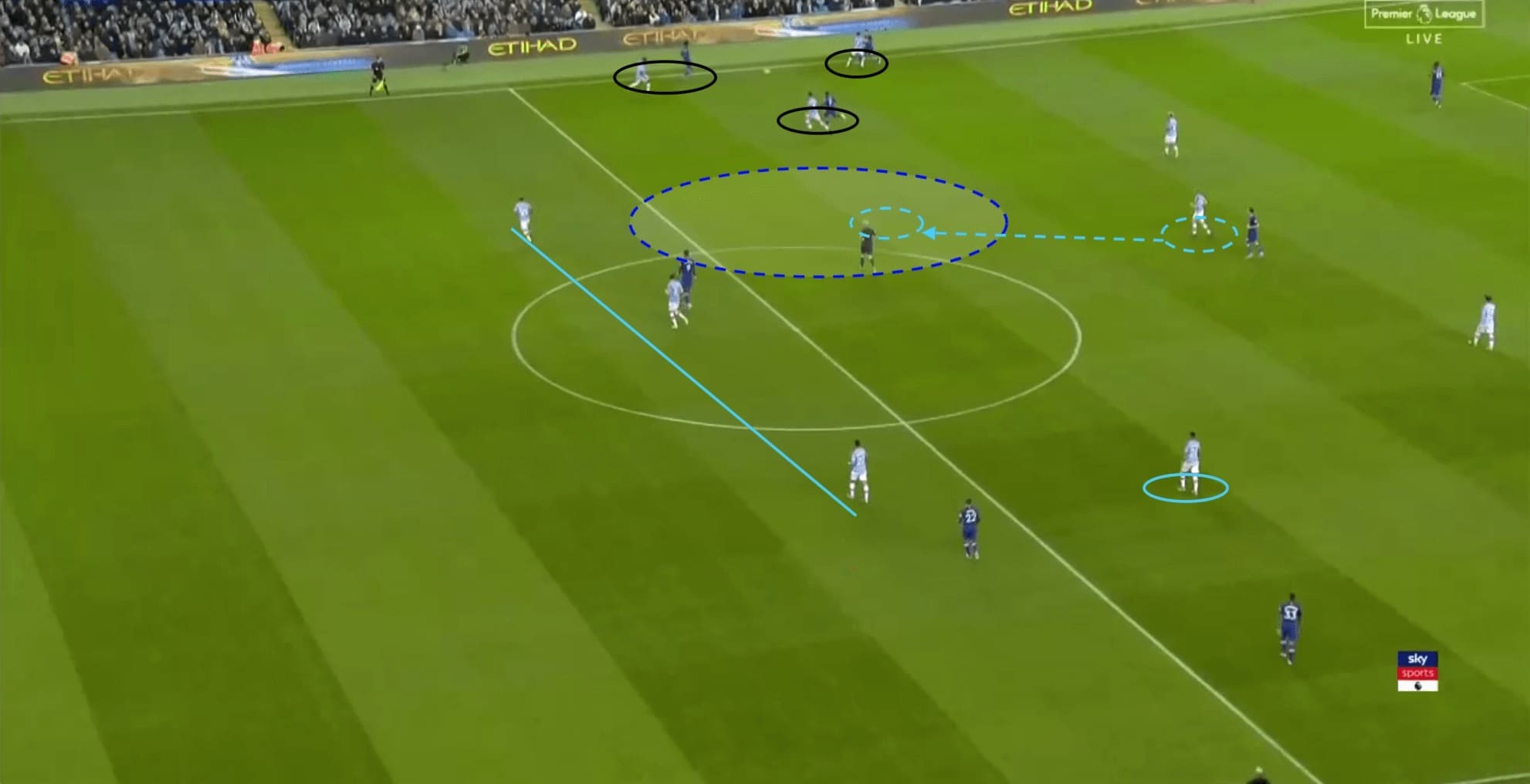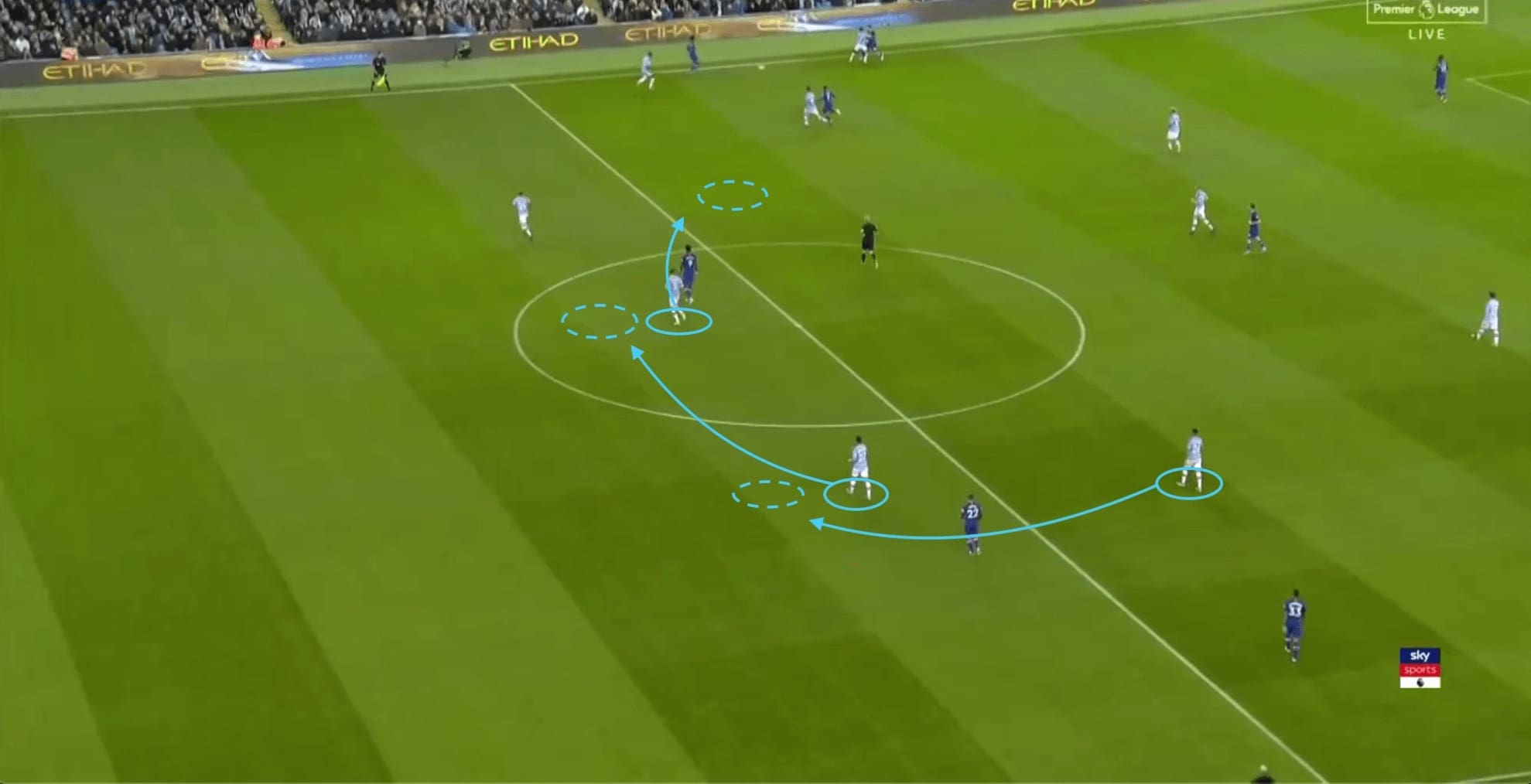There’s nationwide excitement when the international break eventually finishes and the Premier League campaign resumes. The headline of the returning matches came from the Etihad, where Manchester City – who were desperate to maintain pressure on the league leaders Liverpool – faced a dangerous Chelsea side, who under Frank Lampard have found their scoring touch. The game under the lights didn’t disappoint as the Champions came from behind to take a vital three points.
In this tactical analysis, we look at how Chelsea’s tactics nearly scuppered Man City using their dynamic midfield. We also provide an analysis of how Man City tactically overcame their opponents to snatch the three points.
Lineups

The hosts started in their favoured 4-3-3 system, using Rodri Hernández as the deeper-lying playmaker and single pivot in midfield. David Silva and Kevin De Bruyne made up the midfield three, occupying positions further forward in the half-spaces. This narrower more advanced positioning in these channels made them useful links for attacks to be developed.
Pep Guardiola continued with Fernandinho as a centre-back, being partnered by John Stones. The pair looked to hold a high line to squeeze the Chelsea shape and recover possession more aggressively. Whilst this allowed Man City to see more of the ball for periods, it left them vulnerable in defensive transition which we look at later.
The attacking three consisted of Raheem Sterling and Riyad Mahrez on the wings. In sustained possession, the pair maintained their wide positioning to open gaps in the half-spaces for the advancing midfielders. As attacks developed, however, their roles differed slightly. Sterling made sharp bursts inside in an attempt to penetrate behind the Chelsea backline. Mahrez, on the other hand, received the ball to feet and used his dribbling ability to attack outside-to-in at Emerson. This asymmetrical approach made City unpredictable in their build-up play which led to them achieving an xG of 1.25.
The visitors matched their opponents in a dynamic 4-3-3 system. The usual suspects of N’golo Kanté, Jorginho and Mateo Kovačić made up the midfield three. Under Frank Lampard, the labels attached to these players have been relinquished as they now operate on a fluid rotational axis. This system allows the single-pivot to alternate, making it easier to build-up play through the phases. This, however, led to problems as a lack of clear designation occasionally left Chelsea disorganised and easy to play through.
Chelsea started with Willian and Christian Pulisic as the wide midfielders. The pair looked to stay narrow, reducing the horizontal space between themselves and Tammy Abraham. The reason for this was that in offensive transition the trio could use their pace and close positioning to attempt fast interchanges to break in behind the high Man City line.
The story
In possession, the hosts sought to implement their Guardiola-style by using short passes to methodically build through each phase of the pitch. Rodri dropped deeper to collect possession from his centre-backs and looked to develop the attacks by using the open passing channels into the full-backs. Or when the opportunity presented itself, a more penetrative pass into Silva or De Bruyne, who as we can see below operated much further forward than their midfield partner. This was stifled early on by the visitors who looked to get in the faces of the home side.

Off the ball, Man City looked unsure of how to deal with Chelsea who were attempting to match their aggression. At first, they operated a higher man-to-man press, supported by the high defensive line in, which allowed them to go in search of aggressive recoveries.

This, however, became unsustainable due to the threat Chelsea were showing in behind their defensive line, and as a result, the Champions were forced to adjust to a more containing system and wait for triggers to move into a man-to-man press. This is demonstrated by the PPDA chart below, where we can see how Man City significantly drop their aggression in periods of the game.

As for the visitors, they started the game frantically, looking to take the game to Man City. They did this by implementing an organised system out of possession which saw them turn over the ball frequently, which they then used as a platform to catch Man City in defensive transition – where they are vulnerable. This is explained below.

The first stage of Chelsea’s tactics when out of possession started with an organised structure being implemented in the form of a mid-block. The midfield three would push high, moving tight onto Silva and De Bruyne. This was supported by the attacking three who situated themselves narrow and close to the second line of press. As we can see above, this prevented Man City from playing directly through the heart of the pitch, and if they did opt to do so, any recoveries could be quickly turned into a counter-attack.

As a result, the home side funnelled possession into their full-backs. It was at this point where the system deviated from being a containing structure and transformed into an aggressive high press.

Once the horizontal pass was played by the centre-back to the full-back, Chelsea triggered their man-to-man press. Kovačić continued to be aggressive and pushed up onto Rodri in order to force Man City backwards. This bold strategy saw immediate success as the away side took the lead with a tidy Kanté finish. But as Man City have shown against other sides who have ventured into the Etihad with an aggressive mindset, eventually, they will find gaps to exploit.
High and dry
Though they did eventually turn the game to their advantage, Man City are showing a weakness which will give teams hope. The higher line being held by Stones and Fernandinho is vulnerable to exploitation, which Chelsea nearly executed perfectly. This is analysed below.

In the image above, Chelsea have possession in a 3v3 on the right-wing. Silva has moved across to support Sterling and Benjamin Mendy who are marking their respective wide players.
Silva’s movement across leaves a large empty space in midfield (highlighted) which De Bruyne is slow to recognise. His positioning should be deeper to help create a more solid defensive structure.
Instead, Willian breaks free from the 3v3 and bursts into the empty space. We can see that Rodri has dropped into the defensive line, to mark Abraham. I personally think there is any need for him to take on this job. If Rodri instead stepped out into the empty space and Stones moved across closer to Abraham, then this goal wouldn’t have happened. Below we can see an alternative way Man City could have dealt with this situation.

However, as Guardiola likes to operate an inverted full-back, João Cancelo (highlighted) has taken up and advanced position out of the backline and inverted himself. This positioning means Stones can’t move closer to his defensive partner, Fernandinho, as he can sense players over his shoulder. By moving Rodri out of the defensive line would have created a 4v3 in the initial phase of the attack and snuffed out the trouble as soon as Willian broke away.

Instead, no one is there to do so and Cancelo is taken out the game trying to cover the large vacancy infield. Willian, however, is too fast and leaves three Man City players behind, giving himself several options to penetrate the home side. Unfortunately for Chelsea, they were unable to punish this system implemented by Man City who gave the visitors plenty of opportunities to do so.
Conclusion
Another defeat against a ‘top six’ side will hurt Lampard, who despite heaping praise on his players will know this business ultimately deals in the currency of results. His Chelsea side are looking strong going forward, Lampard just needs to find that added steel to help grind out results against the best sides.
Man City will be relieved they managed to turn this game around. A second successive defeat would surely have spelt the end of their title hunt, even before the Christmas break. Their goal-scoring ability still remains, with team fluidity and individual brilliance carving out chances for the Manchester club. Guardiola will know, however, his back four are still a liability and without a few tactical tweaks, its only a matter of time before more points are dropped.

If you love tactical analysis, then you’ll love the digital magazines from totalfootballanalysis.com – a guaranteed 100+ pages of pure tactical analysis covering topics from the Premier League, Serie A, La Liga, Bundesliga and many, many more. Buy your copy of the November issue for just ₤4.99 here





Comments